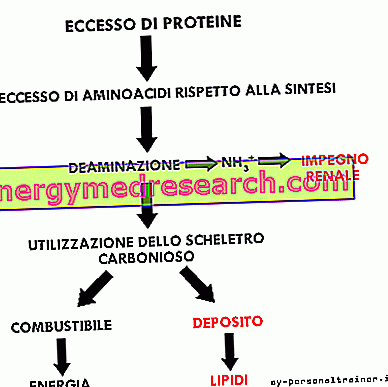Generality
A tendon cyst, or synovial cyst, is a bulge filled with synovial fluid that develops next to a joint or tendon.

More frequent among women and people aged between 20 and 40, tendon cysts are often asymptomatic; when they are symptomatic, they are responsible for pain, tingling, numbness and muscle weakness.
The most frequent sites of tendon cysts are: the back of the hand, the wrist and the palm of the wrist.
The viability of a treatment depends on the presence or absence of symptoms: an asymptomatic tendon cyst does not require any type of therapy.
What is a tendon cyst?
A tendon cyst, or synovial cyst, is a bulge or a pouch containing fluid, of a non-cancerous nature, which takes shape near a joint or tendon .
The size of a tendon cyst varies from case to case: some individuals develop tendon cysts as large as a pea; others, instead, develop tendon cysts the size of a golf ball.
Generally, the fluid contained in a tendon cyst is synovial fluid . Dense, sticky, colorless and with a jelly-like consistency, synovial fluid is a substance physiologically present in all synovial joints, whose function is to preserve the various joint components (ligaments, tendons, joint capsule, etc.) from friction and rubbing.
JOINTS AND TENDONS: WHAT ARE THEY?
The joints are those anatomical elements, sometimes even very complex, which put two or more bones in communication with each other and guarantee a certain mobility for the skeleton.
Tendons, on the other hand, are formations of fibrous connective tissue, with a certain flexibility, which unite a skeletal muscle with a bone.
POSSIBLE OFFICES OF THE CINE TENDINEE
The most common sites of tendon cysts are: the back of the hand and wrist and the palm of the wrist.
The less common onset points, however, are:
- The base of the fingers of the hand, on the palm side. Tendon cysts that form in these sites generally have dimensions comparable to those of a pea;
- The fingertips of the hand. Tendon cysts located in these areas are also called mucous cysts;
- The outer part of the knee;
- The outer part of the ankle;
- The back of the foot.
Epidemiology
Episodes of tendon cysts are more frequent in women and concern, for almost 70% of cases, subjects aged between 20 and 40 years.
The formation of a tendon cyst can also affect very young subjects, but it is a very rare phenomenon.
Causes
Despite numerous studies on the subject, the precise causes that induce the formation of a tendon cyst are unclear. According to some experts, tendon cysts are the consequence of traumatic events affecting the joint or tendon element located nearby; according to other experts, instead, they would be the result of a defect in the joint capsule or in the synovial sheath, respectively, of the neighboring joint or of the nearby tendon.
Between the two theories mentioned above, the second would seem the most reliable.
RISK FACTORS OF TENDINEE CYST
Several clinical and statistical studies have shown that they are more subject to tendon cysts:
- Women;
- People aged between 20 and 40;
- People suffering from osteoarthritis (or arthrosis);
- Individuals with a history of trauma to the joints and / or tendons.
Symptoms, signs and complications
Tendon cysts are immobile, they have a diameter that measures, on average, 2.5 centimeters and they have the consistency of a soft mass.
The final aspect of a generic tendon cyst can be the result of a sudden or gradual training process. If the training is sudden, the bulge may also appear overnight; if instead the formation is gradual, the bulging mass appears progressively.
Sometimes, it is possible that a seemingly stable tendon cyst at some point becomes even larger.
IS IT CAUSE OF SYMPTOMS?
In most cases, tendon cysts are asymptomatic, meaning they do not cause any particular symptoms or disorders. More rarely, they can cause pain, tingling, numbness and / or muscle weakness.
The aforementioned symptomatology appears in all those cases in which a tendon cyst compresses the components of a joint or develops near a nerve end and causes the crushing of the latter.
COMPLICATIONS
A symptomatic tendon cyst can prevent the execution of certain movements with the joint near which it arises.
For example, in the case of symptomatic tendon cysts in the hands, the affected subjects may have difficulty bending the wrist or fingers. These difficulties, therefore, can have repercussions on some daily activities, such as turning the car or house keys or opening a bottle.
WHEN TO REFER TO THE DOCTOR?
Episodes of tendon cysts are not to be considered medical emergencies. However, their occurrence always deserves the attention of the doctor, as a precaution.
It is especially important to seek medical attention if you have symptoms, such as pain, tingling, etc.
Diagnosis
In general, physical examination and medical history are sufficient for a correct diagnosis of tendon cysts.
However, in some particular circumstances, doctors could prescribe more thorough tests, such as a nuclear magnetic resonance of the anatomical portion concerned, an ultrasound of the swollen mass and aspiration, and the consequent analysis of the synovial fluid contained within the cyst.
Among the special circumstances that may require the use of the aforementioned tests, include a suspected condition of arthritis and a suspected presence of a malignant tumor.
OBJECTIVE AND ANAMNESIS EXAMINATION
- The physical examination is the set of diagnostic maneuvers, carried out by the doctor, to verify the presence or absence, in the patient, of signs indicative of an abnormal condition.
For example, in the presence of a suspected tendon cyst, one of the classic diagnostic maneuvers consists in applying pressure on the bulge and assessing whether the latter is wet or rigid. A bulge of soft consistency is indicative of a synovial cyst.
- The anamnesis, on the other hand, is the collection and critical study of symptoms and facts of medical interest, reported by the patient or his family members (NB: family members are involved, above all, when the patient is small).
In the presence of a suspected tendon cyst, the anamnesis can be used to understand whether the bulge is compressing a nerve end or not.
SUCTION AND LABORATORY ANALYSIS OF THE LIQUID
Aspiration and laboratory analysis of the liquid contained in tendon cysts are the most reliable diagnostic tests that eliminate any doubt about the nature of the swelling.
Therapy
Treatment of a tendon cyst depends on the presence or absence of symptoms.
In fact, the presence of asymptomatic tendon cysts does not require any kind of therapy; in these situations, the only advice of doctors is to monitor the situation to contact an expert on the occurrence of an enlargement of the swelling or the appearance of symptoms.
The presence of symptomatic tendon cysts, on the other hand, is a completely different situation and requires the planning of a specific treatment.
Treatment options for symptomatic tendon cysts include:
- The immobilization of the anatomic portion presenting the tendon cyst. This remedy should prevent further expansion of the cyst and, above all, favor its spontaneous reabsorption;
- The aspiration of the synovial fluid contained within the tendon cyst. The treating physician draws in the synovial fluid using a needle, which he inserts into the tendon cyst.
This medical treatment is effective, but it is possible that, after its implementation, the synovial cyst may reform.
In some situations, after aspiration, the doctor could give an injection of corticosteroid drugs, for anti-inflammatory purposes;
- Surgical removal of tendon cysts . Surgery is used only in extreme cases and only when previous treatments have been ineffective.
The surgical removal procedure involves the elimination of the cyst and what keeps it joined to the joint or tendon.
There are two possible operative techniques: the "open" operative technique and the operative technique in arthroscopy.
Surgical removal of tendon cysts is a safe practice, but not completely risk-free. Among the main complications, there is the involuntary damage to anatomical structures - including nerves, blood vessels and tendons - adjacent to the tendon cyst.
Prognosis
Asymptomatic tendon cysts have a positive prognosis, unless they become larger and somehow come into contact with some nerve endings or some joint element.
As for symptomatic tendon cysts, the prognosis is slightly different. In such circumstances, treatments such as aspiration of synovial fluid or surgical removal of the complete cyst can give excellent results, but they can also end with nothing and the recurrence of a recurrence (ie the reappearance) of the cyst, in the same position).
According to a statistical survey carried out on a large number of samples, recurrences are more frequent after aspirations of the synovial fluid, than after surgery.
Prevention
Currently, it is not possible to indicate behaviors or remedies that prevent, with absolute certainty, the formation of a tendon cyst, as the triggering causes are not yet clear.
In fact, it will be possible to talk about prevention only after the identification of precise physiopathological mechanisms and the precise factors that induce episodes of tendon cysts.



